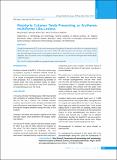Please use this identifier to cite or link to this item:
https://hdl.handle.net/20.500.14356/1447Full metadata record
| DC Field | Value | Language |
|---|---|---|
| dc.contributor.author | Parajuli, Niraj | - |
| dc.contributor.author | Jha, Harendra Kumar | - |
| dc.contributor.author | Jonkman, Marcel F | - |
| dc.date.accessioned | 2023-05-12T06:52:19Z | - |
| dc.date.available | 2023-05-12T06:52:19Z | - |
| dc.date.issued | 2019 | - |
| dc.identifier.citation | ParajuliN., JhaH. K., & JonkmanM. F. (2019). Porphyria Cutanea Tarda Presenting as Erythema-multiforme Like Lesions. Journal of Nepal Health Research Council, 17(01), 119-121. https://doi.org/10.33314/jnhrc.v17i01.1132 | en_US |
| dc.identifier.issn | Print ISSN: 1727-5482; Online ISSN: 1999-6217 | - |
| dc.identifier.uri | http://103.69.126.140:8080/handle/20.500.14356/1447 | - |
| dc.description | Case Report | en_US |
| dc.description.abstract | Abstract Porphyria cutaneatarda, is the most common type of porphyria.It is characterized by defective uroporphyrinogen III decarboxylase enzyme.It presents with erosion, bulla with milia formation and sometimes with hypertrichosis and abnormal pigmentation mostly on the photo-exposed sites. A urine fluorescence of coral red color helps in the diagnosis. Here, we present a rare case of porphyria cutanea tarda in a 15 years old male who presented with multiple targetoid plaques. Keywords: Erythema-multiforme; porphyria cutanea tarda; targetoid. | en_US |
| dc.language.iso | en | en_US |
| dc.publisher | Nepal Health Research Council | en_US |
| dc.relation.ispartofseries | Jan-March, 2019;1132 | - |
| dc.subject | Erythema-multiforme | en_US |
| dc.subject | Porphyria cutanea tarda | en_US |
| dc.subject | Targetoid | en_US |
| dc.title | Porphyria Cutanea Tarda Presenting as Erythema-multiforme Like Lesions | en_US |
| dc.type | Journal Article | en_US |
| local.journal.category | Case Report | - |
| Appears in Collections: | Vol. 17 No. 1 Issue 42 Jan - Mar 2019 | |
Files in This Item:
| File | Description | Size | Format | |
|---|---|---|---|---|
| 1132-Manuscript-9283-1-10-20190429.pdf | Fulltext Download | 444.63 kB | Adobe PDF |  View/Open |
Items in DSpace are protected by copyright, with all rights reserved, unless otherwise indicated.
